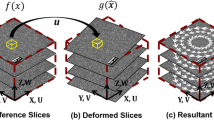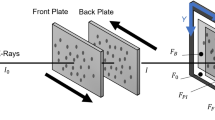Abstract
Dynamic x-rays have been used to follow the deformation ahead of a steel ball fired into a mock-up of a generic cylindrical rocket motor. The impact was arranged to intersect a sparse lead powder layer within the mock explosive that created a random speckle pattern on x-ray film. Three different digital image correlation programs are compared to examine any sensitivity to the sub-optimal speckle pattern produced by the lead powder. An identical output data reduction method was used in all cases to aid comparison. All three correlation methods were able analyze the deformation, but all had intricacies that would require more detailed optimization of the data reduction in order to fully exploit the technique. Quantitative analysis showed that the three methods agreed closely in estimations of rigid body displacements between a pair of representative x-ray images. It was discovered that the deformation caused by the ball impact was highly localized and the useful data available about the deformation pattern was sparse. This limits the applicability of this technique to this specific application. Extensive cracking was not observed that would have aided the development of computer-based models for prediction of such impact events. The x-ray technique was however excellent for determining the ball position as a function of time after impact.









Similar content being viewed by others
References
Hild F, Roux S (2006) Digital image correlation: from displacement measurement to identification of elastic properties—a review. Strain 42(2):69–80
Sjodahl M (1994) Electronic speckle photography—increased accuracy by nonintegral pixel shifting. J Appl Opt 33:6667–6673
Schreier HW, Braasch J, Sutton MA (2000) On the systematic errors in digital image correlation. Opt Eng 39(11):2915–2921
Asay B (2010) Shock wave science and technology reference library, vol 5: non-shock initiation of explosives, 1 edn. Springer
Bruck HA, McNeill SR, Sutton MA, Peters WH (1989) Digital image correlation using Newton–Raphson method of partial differential correction. Exp Mech 29:261–267
Peters WH, Ranson WF (1982) Digital imaging techniques in experimental stress analysis. Opt Eng 21:427
Peters WH, Ranson WF (1983) Application of digital correlation methods to rigid body mechanics. Opt Eng 22:738–742
Sutton MA, Wolters WJ, Peters WH, Ranson WF, McNeill SR (1983) Determination of displacements using an improved digital correlation method. Image Vis Comput 1:133–139
Cheng DJ, Chiang FP, Tan YS, Don HS (1993) Digital speckle-displacement measurement using a complex spectrum method. Appl Opt 32(11):1839–1849
Eckstein A, Vlachos PP (2009) Digital particle image velocimetry (DPIV) robust phase correlation. Meas Sci Technol 20:055,401
Sjodahl M (1997) Accuracy in electronic speckle photography. J Appl Opt 36:2875–2885
Sjodahl M, Benckert L (1993) Electronic speckle photography—analysis of an algorithm giving the displacement with subpixel accuracy. J Appl Opt 32:2278–2284
Wang YQ, Sutton MA, Schreier HW (2009) Quantatative error assessment in pattern matching: effects of intensity pattern noise, interploation, subset size and image contrast on motion measurments. J Strain 45:160–178
White DJ, Take WA, Bolton MD (2003) Soil deformation measurement using particle image velocimetry (PIV) and photogrammetry. Geotechnique 53(7):619–631
Acknowledgements
Los Alamos National Laboratory is operated by Los Alamos National Security, LLC, for the NNSA of the U.S. Department of Energy under contract DE-AC52-06NA25396. This research was partially sponsored by the Joint DoD/DoE Munitions Technology Development Program.
Author information
Authors and Affiliations
Corresponding author
Rights and permissions
About this article
Cite this article
Rae, P.J., Williamson, D.M. & Addiss, J. A Comparison of 3 Digital Image Correlation Techniques on Necessarily Suboptimal Random Patterns Recorded By X-Ray. Exp Mech 51, 467–477 (2011). https://doi.org/10.1007/s11340-010-9444-1
Received:
Accepted:
Published:
Issue Date:
DOI: https://doi.org/10.1007/s11340-010-9444-1




